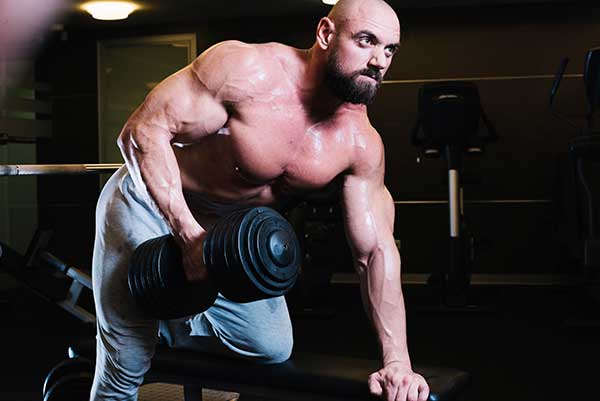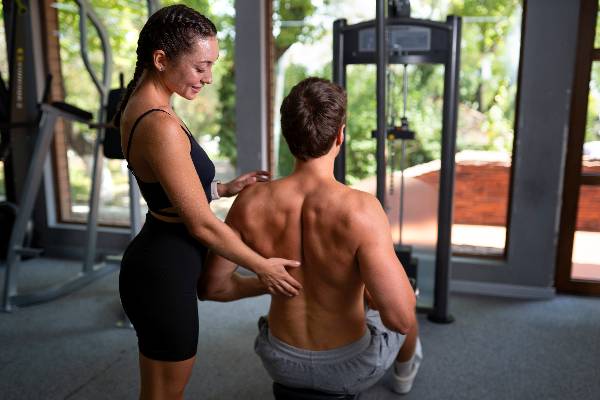Best Exercises to Target The Upper Back
Introduction to the importance of a strong upper back
A strong upper back is more than just an aesthetic asset; it plays a crucial role in your overall strength and posture. Whether you’re lifting weights, sitting at a desk, or engaging in everyday activities, the muscles in this area are vital for stability and functionality. Neglecting them can lead to poor posture, discomfort, and even injuries down the line.
Strengthening your upper back not only enhances your athletic performance but also contributes to better alignment and reduces fatigue throughout daily tasks. So why not invest some time into developing those essential muscles? Dive into the world of effective exercises that specifically target the upper back, helping you build strength while enhancing both form and function. Let’s explore how you can achieve a well-defined upper back with targeted workouts designed for success!
Anatomy of the upper back muscles
The upper back is a complex region composed of several key muscle groups. Primarily, it includes the trapezius, rhomboids, and latissimus dorsi.
The trapezius extends from the base of the skull down to the middle of your back. It plays a crucial role in moving and stabilizing your shoulder blades.
Rhomboids sit beneath the trapezius and connect your spine to your shoulder blades. They are essential for retracting them during various movements.
Latissimus dorsi, or “lats,” stretch across the sides of your body, contributing significantly to upper body strength and stability.
These muscles work together to support good posture and facilitate arm movement while also playing a vital part in overall functional fitness. Recognizing their importance can help you focus on exercises that enhance these areas effectively.
Top exercises to target the upper back:
Pull-Ups and Chin-Ups are fantastic for building upper back strength. They engage multiple muscles while targeting the lats and traps effectively. Just hang from a bar, pull yourself up until your chin clears it.
Bent Over Rows focus on the middle of the back. With dumbbells or a barbell in hand, hinge at your hips and pull weights towards your waist. Keep that back straight to avoid strain.
Lat Pulldowns are an excellent alternative if you struggle with pull-ups. Sit at a machine, grip the bar wider than shoulder-width, and draw it down towards your chest while keeping good posture.
Reverse Flyes target those rear delts and upper traps beautifully. Bend slightly forward with dumbbells in each hand, then raise them out to the side like you’re embracing someone behind you.
Shoulder Shrugs round off this list perfectly by isolating those upper trapezius muscles. Simply lift your shoulders toward your ears, hold briefly, then lower them down again.
– Pull-Ups/Chin-Ups
Pull-ups and chin-ups are powerful bodyweight exercises that effectively target the upper back. These movements engage multiple muscle groups, including your lats, traps, and rhomboids.
For pull-ups, grip the bar with palms facing away from you. As you pull your body upward, focus on squeezing your shoulder blades together. This helps activate those crucial upper back muscles.
Chin-ups involve a supine grip—palms facing towards you—which shifts some emphasis to the biceps while still engaging the upper back significantly. The technique is similar: lift yourself until your chin clears the bar.
Both exercises can be challenging at first but offer incredible strength benefits over time. Incorporating variations like assisted pull-ups or using resistance bands can help build up to full versions gradually. Remember to maintain control throughout each movement for maximum effectiveness and safety in targeting your upper back muscles efficiently.
– Bent Over Rows
Bent Over Rows are a fantastic exercise for targeting the upper back. They engage multiple muscle groups, including the lats and rhomboids. This compound movement not only builds strength but also improves posture.
To perform Bent Over Rows effectively, start by standing with your feet shoulder-width apart. Hold a barbell or dumbbells in front of you with an overhand grip. Hinge at your hips while keeping your back straight, bending slightly at your knees.
Pull the weights towards your lower rib cage while squeezing your shoulder blades together. Maintain control throughout the motion to maximize effectiveness and reduce injury risk.
Remember to keep your core engaged during this exercise; it helps maintain balance and stability as you lift heavier weights. Adjusting weight gradually will allow for muscle growth without overstraining yourself.
– Lat Pulldowns
Lat pulldowns are a fantastic exercise for targeting the upper back, particularly the latissimus dorsi. This muscle runs from your lower back up to your shoulders, giving you that V-taper look.
To perform a lat pulldown, sit at a cable machine with an overhand grip on the bar. Start with your arms fully extended overhead, then pull the bar down towards your chest. Focus on squeezing your shoulder blades together as you lower it.
Maintaining good posture is crucial here; keep your spine neutral and avoid leaning backward excessively. Ensure you’re controlling both the upward and downward phases of the movement for maximum effectiveness.
Incorporating this exercise into your routine can add width to your upper body while improving overall strength and stability in daily activities. Plus, it’s adaptable for different fitness levels by adjusting weights or grips.
– Reverse Flyes
Reverse flyes are an excellent exercise for targeting the upper back, specifically the rear deltoids and rhomboids. This movement helps improve posture by strengthening the muscles that often weaken from prolonged sitting or poor alignment.
To perform reverse flyes, start by standing with your feet shoulder-width apart. Hold a dumbbell in each hand and hinge at your hips so your torso is parallel to the ground. Keep a slight bend in your knees for stability.
With palms facing each other, lift both weights outward until they reach shoulder height. Focus on squeezing your shoulder blades together at the top of the movement. Lower them slowly to maintain control.
Remember to keep your core engaged throughout this exercise. Proper form is essential not only for effectiveness but also to prevent injury as you work towards a stronger upper back.
– Shoulder Shrugs
Shoulder shrugs are an effective exercise for targeting the upper back, particularly the trapezius muscles. These muscles extend from your neck down to your mid-back and play a crucial role in shoulder stability.
To perform shoulder shrugs correctly, stand upright with a dumbbell in each hand. Keep your feet shoulder-width apart and arms relaxed at your sides. Gently lift your shoulders toward your ears while keeping your arms straight. Hold for a second at the top before lowering them back down.
Maintaining proper form is essential to avoid strain. Ensure you don’t rotate or lean forward during the movement; focus solely on raising and lowering those shoulders.
Incorporating shoulder shrugs into your routine can enhance posture and reduce tension caused by prolonged sitting or stress. They also help improve overall upper body strength, making other exercises feel more manageable over time.
How to properly perform each exercise with correct form and technique
Pull-Ups and Chin-Ups require a firm grip on the bar. Begin by hanging with arms fully extended. Engage your core, pull your shoulders back, and lift until your chin is above the bar. Lower with control.
For Bent Over Rows, stand tall with feet shoulder-width apart. Bend at the hips while keeping your back flat. Hold the weights close to you as you pull them towards your waist, squeezing your shoulder blades together before lowering.
During Lat Pulldowns, sit down firmly with knees under the pad. Grasp the bar wider than shoulder-width and pull it down towards your upper chest while leaning slightly back. Avoid arching excessively; keep movements smooth.
Reverse Flyes start in a bent-over position holding dumbbells. With slight bends in elbows, raise weights out to the side until they’re level with shoulders – focus on engaging those upper back muscles throughout.
Finish off Shoulder Shrugs by standing straight, holding dumbbells at sides or letting them hang freely. Lift shoulders toward ears slowly and then lower them for full range of motion without rolling forward or backward.
Benefits of a Strong Upper Back
A strong upper back plays a crucial role in overall body function. It supports proper posture, which can reduce the risk of neck and shoulder pain. Good posture not only enhances your appearance but also boosts confidence.
Additionally, an upper back focused workout helps improve performance in various physical activities. From lifting weights to participating in sports, strength in this area allows for better control and stability.
Moreover, a robust upper back aids daily tasks like carrying groceries or moving furniture. You’ll notice these activities become easier with increased strength.
Developing this muscle group contributes to injury prevention. A balanced physique reduces strain on other areas of the body during movement. This means fewer aches and more energy for your day-to-day endeavors.
Tips for incorporating these exercises into your workout routine
To effectively incorporate upper back exercises into your workout routine, start by scheduling dedicated days for back training. Aim for at least once or twice a week to allow adequate recovery.
Mix these exercises with other muscle groups to maintain balance. For instance, pair pull-ups with bicep curls or bent-over rows with chest presses. This combination keeps your workouts dynamic and engaging.
Begin each session with a proper warm-up to prepare the muscles. Dynamic stretches targeting the shoulders and thoracic spine can enhance performance and reduce injury risk.
Gradually increase weights or resistance as you master form and technique. Progression is key in building strength without overexerting yourself.
Listen to your body. If something feels off while performing an exercise, reassess your technique or take breaks as needed. Consistency paired with mindfulness will yield the best results in strengthening your upper back.
Conclusion: The
The importance of developing a strong upper back cannot be overstated. It plays a vital role in supporting your posture and enhancing overall body strength. When you focus on the best exercises to target the upper back, you’ll notice improvements not just in aesthetics but also in functional fitness.
Incorporating pull-ups, bent-over rows, lat pulldowns, reverse flyes, and shoulder shrugs into your routine will yield significant benefits. Each exercise is designed to engage various muscle groups within the upper back while promoting balance and coordination throughout your movements.
Maintaining proper form during these exercises ensures that you’re maximizing their effectiveness while reducing the risk of injury. Remember to keep your core engaged and maintain control throughout each repetition for optimal results.
Adopting these practices into your regular workout regimen can lead to improved posture, reduced tension in daily activities, and greater overall strength. As you progress over time, don’t hesitate to adjust weights or repetitions according to your fitness level.
Building a robust upper back takes time and dedication. By consistently applying this knowledge about targeted exercises within an integrated training program, you’re setting yourself up for success both physically and mentally as you enhance performance across all aspects of life.
- About the Author
- Latest Posts
Johnnie D. Jackow Sr., the founder and CEO of Total Body Fitness, Worldwide, has a long-standing career in the fitness industry. He began as a certified personal trainer in the mid-90s and soon after authored his first weight loss book in 1998. This led to the launch of Total Body Fitness, Nationwide in the USA at the same time. Johnnie gained recognition as the fitness guru of his time, running infomercials on local TV late at night in Houston, Texas. Over the years, he has helped more than 40,000 individuals from all over the world achieve their health and fitness goals. With over 60,000 hours of documented training in integrative functional medicine, he completed his PhD in human physiology in 2010. His primary objective is to assist people in reaching their health and fitness goals through alternative approaches rather than relying solely on conventional medicine and pharmaceutical drugs. Today, with almost three decades of experience under his belt, Johnnie continues to be a leader in health and fitness.








